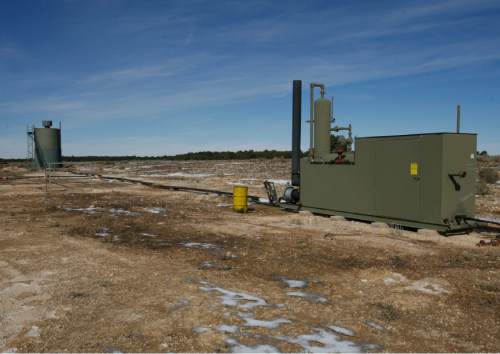This is an archived article that was published on sltrib.com in 2016, and information in the article may be outdated. It is provided only for personal research purposes and may not be reprinted.
The collapse of energy prices hit Utah's oil belt so hard that for a period earlier this year, the drilling of new wells had come to a complete halt — a first in the state in at least the past 48 years.
For a week in February and again in early March, no oil drilling rigs were operating in the entire state. The first was brought online in mid-March, and the number has climbed by one each month. Four are operating, according to the national Baker Hughes rig count.
By contrast, two years ago, 27 rigs were drilling new wells and there were 34 operating a year prior.
The slowdown in Utah's oil sector has been caused by plummeting oil prices, a trend that also has hit state coffers and left thousands in eastern Utah unemployed.
"We've had better times, let me put it that way," said Sen. Kevin Van Tassell, R-Vernal, who represents Utah's Uinta Basin, ground zero for the state's oil industry.
"In my neighborhood, we've seen quite a few people moving and there are others moving now," he said. "We're seeing some homes that are being turned back and some of the vehicles that are [repossessed]. If you don't have money, you can't make your payments."
In 2014, oil prices topped out at $100 a barrel. Last year, they bottomed out at $30 a barrel and have gone as low as $20 a barrel this year. Oil currently is selling for just under $50 a barrel.
"There's a little optimism," said Van Tassell. "I keep hearing from the industry folks that to be sure that there's something going to happen, they've got to have oil at $50 or better for 50 days."
Andrea Wilko, the Legislature's chief economist, told lawmakers Tuesday that production is unlikely to improve soon, forecasting a 20 percent reduction in oil production this year and another 10 percent decrease in 2017.
That means that severance taxes on oil will likely be 13 percent lower next year, Wilko said.
Van Tassell said he saw worse during the 1980s oil bust, but he agreed it likely will be next year before the industry turns around.
Natural-gas production isn't faring much better. Prices dropped by 43 percent in 2015, and production fell by 7 percent — a trend that will continue this year, state economists predict.
The tumbling prices also are being felt on a local level. Each drill rig will create between 30 and 60 jobs, and roughnecks flock to rural communities to do the work in boom times. Now, as that work has ground to a halt, hundreds of rural Utahns are finding themselves out of work and local governments are being hit hard.
Uintah County has lost about 2,000 nonfarm jobs in the past year, according to the latest report and has an unemployment rate of 11.5 percent. Neighboring Duchesne County has bled out 1,400 jobs and has an unemployment rate of 11.1 percent.
Both are nearly triple the statewide average.
Overall, lawmakers were told Tuesday that state revenues likely are to come in about $15 million lower than expected — although, because of unpredictability in the economy, actual revenues may be as much as $100 million less than forecast or as much as $85 million more.
That is due partly to the low oil prices, as well as sluggish corporate taxes and higher-than-anticipated income-tax refunds.
Low inflation, weak business investment, poor wage growth and the loss of sales taxes that are not paid on online purchases also hinder the sales-tax collections.



